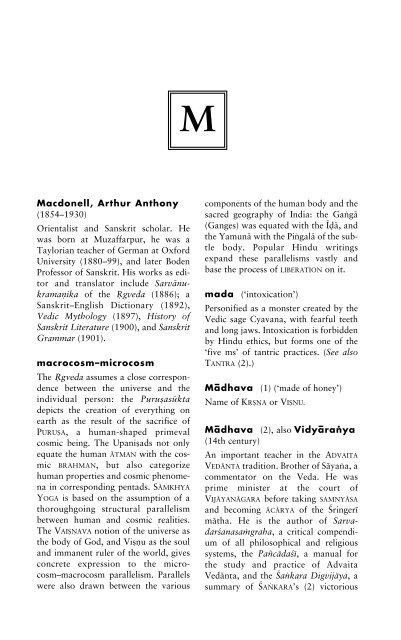A Concise Encyclopedia of Hinduism Klaus K Klostermaie
Create successful ePaper yourself
Turn your PDF publications into a flip-book with our unique Google optimized e-Paper software.
M<br />
Macdonell, Arthur Anthony<br />
(1854–1930)<br />
Orientalist and Sanskrit scholar. He<br />
was born at Muzaffarpur, he was a<br />
Taylorian teacher <strong>of</strong> German at Oxford<br />
University (1880–99), and later Boden<br />
Pr<strong>of</strong>essor <strong>of</strong> Sanskrit. His works as editor<br />
and translator include Sarvänukramaæika<br />
<strong>of</strong> the Øgveda (1886); a<br />
Sanskrit–English Dictionary (1892),<br />
Vedic Mythology (1897), History <strong>of</strong><br />
Sanskrit Literature (1900), and Sanskrit<br />
Grammar (1901).<br />
macrocosm–microcosm<br />
The Øgveda assumes a close correspondence<br />
between the universe and the<br />
individual person: the Puru•asükta<br />
depicts the creation <strong>of</strong> everything on<br />
earth as the result <strong>of</strong> the sacrifice <strong>of</strong><br />
PURUÆA, a human-shaped primeval<br />
cosmic being. The Upani•ads not only<br />
equate the human ÄTMAN with the cosmic<br />
BRAHMAN, but also categorize<br />
human properties and cosmic phenomena<br />
in corresponding pentads. SÄßKHYA<br />
YOGA is based on the assumption <strong>of</strong> a<br />
thoroughgoing structural parallelism<br />
between human and cosmic realities.<br />
The VAIÆŒAVA notion <strong>of</strong> the universe as<br />
the body <strong>of</strong> God, and Vi•æu as the soul<br />
and immanent ruler <strong>of</strong> the world, gives<br />
concrete expression to the microcosm–macrocosm<br />
parallelism. Parallels<br />
were also drawn between the various<br />
components <strong>of</strong> the human body and the<br />
sacred geography <strong>of</strong> India: the Gaögä<br />
(Ganges) was equated with the Ïõä, and<br />
the Yamunä with the Piögalä <strong>of</strong> the subtle<br />
body. Popular Hindu writings<br />
expand these parallelisms vastly and<br />
base the process <strong>of</strong> LIBERATION on it.<br />
mada (‘intoxication’)<br />
Personified as a monster created by the<br />
Vedic sage Cyavana, with fearful teeth<br />
and long jaws. Intoxication is forbidden<br />
by Hindu ethics, but forms one <strong>of</strong> the<br />
‘five ms’ <strong>of</strong> tantric practices. (See also<br />
TANTRA (2).)<br />
Mädhava (1) (‘made <strong>of</strong> honey’)<br />
Name <strong>of</strong> KØÆŒA or VIÆŒU.<br />
Mädhava (2), also Vidyäraöya<br />
(14th century)<br />
An important teacher in the ADVAITA<br />
VEDÄNTA tradition. Brother <strong>of</strong> Säyaöa, a<br />
commentator on the Veda. He was<br />
prime minister at the court <strong>of</strong><br />
VIJÄYANÄGARA before taking SAMNYÄSA<br />
and becoming ÄCÄRYA <strong>of</strong> the Ÿringerï<br />
mätha. He is the author <strong>of</strong> Sarvadarÿanasaƒgraha,<br />
a critical compendium<br />
<strong>of</strong> all philosophical and religious<br />
systems, the Pañcädaÿï, a manual for<br />
the study and practice <strong>of</strong> Advaita<br />
Vedänta, and the Ÿaökara Digvijäya, a<br />
summary <strong>of</strong> ŸA¢KARA’s (2) victorious


















